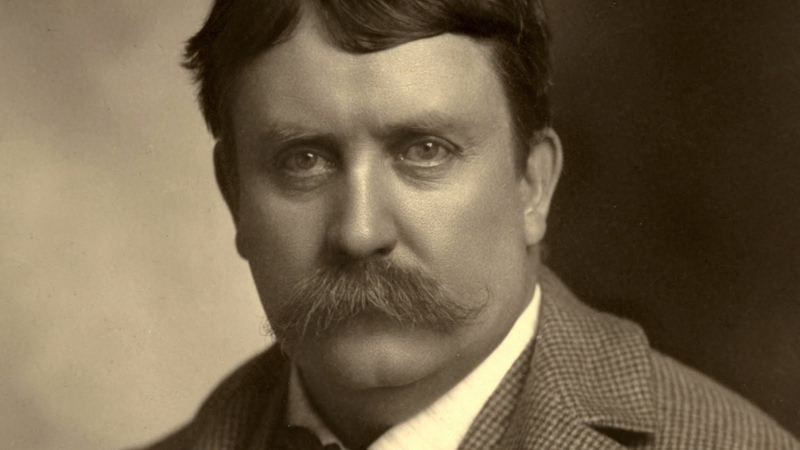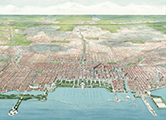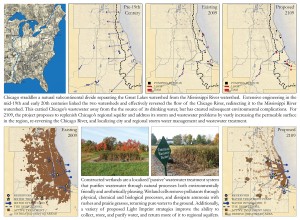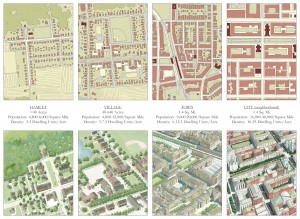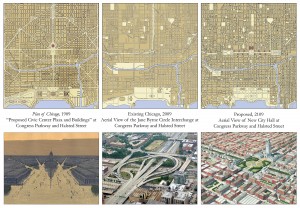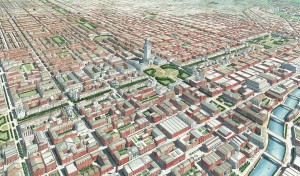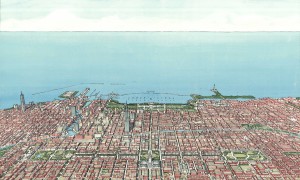
Welcome to After Burnham. The enlargeable images on this page briefly summarize visually and verbally the main themes of our project: the scope of The Notre Dame Plan of Chicago 2109 (aka Chicago 2109), and its proposals for metropolitan Chicago land use, waste and storm water management, regional transportation, settlement types, and proposals for Chicago’s historic center. In addition, the links at the top of this and every page connect you to every aspect of Chicago 2109 in greater detail —including more than twenty proposals for specific neighborhoods, towns, and villages beyond Chicago’s historic center— as well as to the larger body of work of the Notre Dame graduate urban design studio that constitutes the institutional and intellectual context of the After Burnham project.
The rise of the hyper-modern city, whether global city1 or megacity, raises a related series of too often unasked questions: about its place in nature; about its relationship to its surrounding natural and agrarian landscape (which is not exactly the same question); about its purpose/s in comparison to the historic purpose of cities as places par excellence for human flourishing (with all the family-related questions that then follow about both economic opportunity and suitability for children); about the moral and spiritual sensibilities embodied in its physical and spatial forms; and about its status (and quality) as a human artifact, with all attendant implications about the significance of individual and communal human agency. Given the complexity of the subject, how and by what criteria might we begin both to assess the merits and correct any deficiencies of the hyper-modern city? Such questions and issues are among those that this project seeks to address and engage.
Modernity brings with it certain genuine human goods, and the successes of modernity can be measured in part by dramatic increases in human mobility, life span, and per capita income wherever modern institutions have established themselves. But these successes come at a price. Powerful accounts abound of the human suffering entailed in the transformation of traditional societies into modern societies; and the modern view of nature as raw material for human purposes has resulted in both the potential and the reality of environmental catastrophes at unprecedented scale (often with harshest impact upon the poor) and has created wholly modern eco-discontents. Last but not least, serious questions about the cultural sustainability of modernity arise in light of the individualist / therapeutic / consumerist character-type that modern societies seem to mass-produce.
A long western intellectual tradition dating from Aristotle views cities, character virtue, and human flourishing as intimately and reciprocally related. If true —and we think it is— this should give thoughtful people pause. Ours is a time of exploding urbanization in the modernizing societies of Asia, Africa and South America, and the aftermath of nearly seventy years of American suburbanization. Both of these phenomena represent distinctively modern forms of human settlement, but neither is typically evaluated holistically with respect to the relationship of urban formal order to environmentally and culturally sustainable human wellbeing. One possible reason for this is that questions about nature, cities, culture and human wellbeing are also philosophical and religious questions that pertain to public and common existential goods; but such questions (let alone proposed answers to them) get little if any traction today because for many persons in the modern world —including, notably, persons who are “spiritual-but-not-religious”— philosophy and religion are essentially private. In such a culture modernist and hyper-modernist urbanism therefore proceed apace, their metaphysical assumptions and their own intrinsic nature/s largely un-critiqued. The danger is that the “triumph” of modernist urbanism is pyrrhic, and that contemporary technocratic, instrumentalist, and utilitarian ways of thinking about The City (and eo ipso about human beings) carry unsustainable environmental, economic, moral, spiritual, and (not least) aesthetic costs — a danger identified and underscored in Pope Francis’s recent environmental stewardship encyclical Laudato Si.
On July 4, 1909, at a moment when Chicago was the fastest growing and most quintessentially modern city in the world, the Commercial Club of Chicago published Daniel Burnham and Edward Bennett’s Plan of Chicago. Justly praised to this day for its regional scope and environmental prescience, The Burnham Plan is often criticized for its allegedly autocratic social and design sensibilities. Less commonly celebrated, even by admirers, is that the Plan of Chicago was one of the last efforts (perhaps the greatest) to employ classical principles of architectural, landscape, and urban design in and for and at the scale of a rapidly expanding modern industrial metropolitan region. This it did consciously participating in the long western cultural tradition —a metaphysical realist and sacramental tradition— of classical humanist urbanism.
In its centennial year of 2009, commentators typically treated the Plan of Chicago as a historical document the relevance of which, despite permanent beneficial effects, has passed. The agents of After Burnham differ with that assessment. We think that since the middle of the 20th century architecture and urbanism in Chicago and elsewhere —after following first the logic of modernist and now of hyper-modernist premises— have gone astray in important ways for which The Plan of Chicago remains a potential if unexpected corrective.2 For this reason, University of Notre Dame School of Architecture graduate urban design students, alumni, and faculty have undertaken this project, taking present-day Chicago as a given and the Plan of Chicago as an authoritative (albeit improvable) point of reference. The 100-year vision of After Burnham proposes that and envisions how classical humanist urbanism in conjunction with a foundational respect for the human person and attendant concerns for moral agency, social solidarity, political subsidiarity, environmental stewardship, religious freedom, and public policy attentive to the needs of the involuntarily poor3 —i.e., the common good / natural law substance of modern Catholic Social Teaching— can help locate even the modern metropolis in both nature and sacred order in a manner both symbolically legible and humane; and, in the case of Chicago, can do so in future-oriented ways recognizably continuous with the best historic traditions of both Chicago and western humanist culture.
1 The term global city is used here after the work of Saskia Sassen, The Global City (Princeton, NJ: Princeton University Press, 1991) and her various interpreters. Briefly, in the modern economy productive activities are scattered globally. Participation in the globalized production network depends upon certain kinds of complex financial services that in turn require highly specialized management skills, especially those found in four specific service industries: accounting, advertising, banking, and law. Global cities cluster persons with the skills needed to manage the international trade of certain regionally specific goods. A global city can thus be understood most basically as a significant locus of specialized financial and production services that make the globalized economy run. Beyond these basic criteria however, global cities (or aspiring global cities) are characterized by secondary criteria intended to attract, pay and entertain the specialized talent —what urban theorist Richard Florida dubs, perhaps too glibly, “the creative class”— needed to oversee the global economy; and generally include among other things the presence of major media outlets, significant cultural and entertainment institutions, a large international airport, good public transportation, a prominent city skyline, and other such “urban amenities.” It must be noted that global cities are good for their creative class but not necessarily good for their other residents; that this discrepancy may be systemic; and that the existence of the modern global city may depend entirely upon the ability to easily and relatively inexpensively transport material goods around the world.
2 Note that from 1906 to 1945 the Chicago Cubs won ten National League championships, and were World Champions when the Plan of Chicago was published in 1909. Then from 1945 until 2016 —i.e., during the heyday of Chicago’s embrace of Miesian modernism, later followed by today’s bombastic-but-aimless hyper-modernism— the Cubs did not win even a single NL pennant! Note too however that the revival of the Cubs’ fortunes has been contemporaneous with The Notre Dame Plan of Chicago 2109. Post hoc ergo propter hoc? Let the reader decide.
3 The term “involuntarily poor” is not distinguishing “deserving poor” from “undeserving poor.” It is rather distinguishing persons who are voluntarily poor from persons who are poor against their will. Voluntary poverty is a historic Christian virtue and vocation for those whose vocation it is. In contrast, involuntary poverty thwarts human flourishing; and in Catholic Social Teaching is an economic condition from which, in civil society, public policy should by just means assist individuals and communities to escape.
